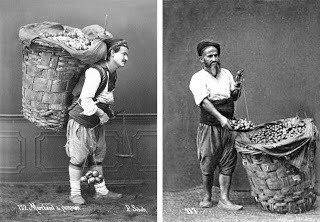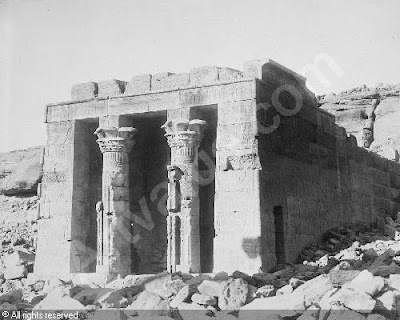 Pascal Sébah
(1823-1886) was an Ottoman pioneer photographer who worked in Istanbul. He was born in Istanbul to a Syrian Catholic father and an
Armenian mother. In 1857 he opened his first photography studio in Istanbul and by 1873 was successful enough to open another
studio in Cairo.
Pascal Sébah
(1823-1886) was an Ottoman pioneer photographer who worked in Istanbul. He was born in Istanbul to a Syrian Catholic father and an
Armenian mother. In 1857 he opened his first photography studio in Istanbul and by 1873 was successful enough to open another
studio in Cairo.
Pascal Sebah composed
of many diverse peoples, was the capital of the Ottomon Empire and Sebah's
career coincided with intense Western European interest in the
"Orient," which was viewed as exotic and fascinating.
Constantinopolitan photographers, such as Sebah and Abdullah Freres, had a
ready market selling images to tourists -- of the city, ancient ruins in the
surrounding area, portraits, and local people in traditional costumes, often
holding water pipes. Sebah rose to prominence because of his well-organized
compositions, careful lighting, effective posing, attractive models, great
attention to detail, and for the excellent print quality produced by his
technician, A. Laroche.
Sebah's career was
accelerated through his collaboration with the artist, Osman Hamdi Bey
(1842-1910). Osman Hamdi Bey posed models, often dressed in elaborate costumes,
for Sebah to photograph. The painter then used Sebah's photographs for his
celebrated Orientalist oil paintings. In 1873, Osman Hamdi Bey was appointed by
the Ottoman court to direct the Ottoman exhibition in Vienna and commissioned Sebah to produce
large photographs of models wearing costumes for a sumptuous album, Les
Costumes Populaires de la Turquie. The album earned Sebah a gold medal, awarded
by the Viennese organizers, and another medal from the Ottoman Sultan
Abdulaziz. In that same exceptional year, Sebah opened a branch in Egypt. Sebah's
prints are signed P. Sebah.
 After Sebah's
death, his brother Cosimi ran the studio for a few years. Sebah's son, Johannes
(Jean) became involved in the business in 1890, when he was only 16 years old.
In that year, Jean formed a partnership with a Frenchman, Policarpe Joaillier,
and thereafter the studio was known as Sebah & Joaillier. Some images by
Jean are signed J.P. Sebah on the negative, as he began putting his initial in
front of his father's. Others from this period are signed Sebah &
Joaillier. Joaillier returned to Paris
in the early 1900s, but Jean Sebah continued the studio, forming a partnership
in 1910 with Hagop Iskender and Leo Perpignani. The latter left the firm in
1914. Jean Sebah and Hagop Iskender retired in 1934, leaving the business to
Iskender's son, Bedros Iskender and his partner, Ismail Insel. Ismail Insel
eventually became sole partner and renamed the studio Foto Sabah, which
remained in business until 1952. [Sabah means
"morning" in Turkish.] With all the changes, the studio that Pascal
Sebah began in 1857 lasted 95 years.
After Sebah's
death, his brother Cosimi ran the studio for a few years. Sebah's son, Johannes
(Jean) became involved in the business in 1890, when he was only 16 years old.
In that year, Jean formed a partnership with a Frenchman, Policarpe Joaillier,
and thereafter the studio was known as Sebah & Joaillier. Some images by
Jean are signed J.P. Sebah on the negative, as he began putting his initial in
front of his father's. Others from this period are signed Sebah &
Joaillier. Joaillier returned to Paris
in the early 1900s, but Jean Sebah continued the studio, forming a partnership
in 1910 with Hagop Iskender and Leo Perpignani. The latter left the firm in
1914. Jean Sebah and Hagop Iskender retired in 1934, leaving the business to
Iskender's son, Bedros Iskender and his partner, Ismail Insel. Ismail Insel
eventually became sole partner and renamed the studio Foto Sabah, which
remained in business until 1952. [Sabah means
"morning" in Turkish.] With all the changes, the studio that Pascal
Sebah began in 1857 lasted 95 years.
Pascal Sebah died
on June 15, 1886, and, since he was a Catholic, was buried in the Latin
cemetery in Ferikoy. His son, Jean, is also buried there. Jean died on June 6,
1947, at the age of 75.



















_-_n._489_-_Tombeaux_des_Mamelouks_-_Ciaro_-_1880s.jpg)





































_-_n._173_-_La_Mosqu%C3%A9e_de_S.te_Sophie_et_l%27Hippodrome.jpg)





.jpg)



